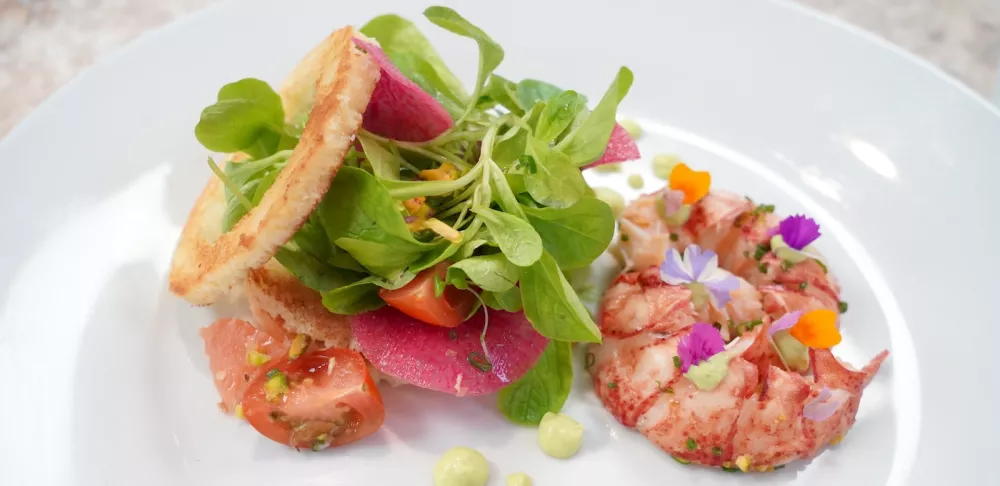When different flavors come together harmoniously in a dish as a perfect pairing, it can be a thrilling culinary sensation, but one that may be difficult to describe.
Peanut butter and grape jelly, for example, is a very familiar and comforting flavor combination to Americans, but how does the magic actually happen between a roasted, savory legume and a sweet, fruity compote? Kidney beans, another legume, and watermelon, for example, hardly come together in quite the same way.
As a more complex case, I recall my first experience with a Thai food recipe. Before takeout pad thai noodles became ubiquitous in America, I couldn’t fathom how ingredients such as peanut butter, mint, lime, and bell peppers could possibly get on the same page — but they absolutely did.
ICE Los Angeles Senior Chef-Instructor Stephen Chavez shares one of his favorite, unexpected flavor pairings: “One of my favorites has always been shellfish and vanilla,” he says. “It does seem kind of weird, but they really complement each other, and the vanilla almost makes the shellfish taste smoother and creamier.”
The art and science behind why flavors pair well is complex and fascinating, with roots in biology, culture, tradition, and chemistry.
Balance in Flavor Pairing
Taste and flavor aren’t necessarily the same thing, but are both important to consider when it comes to flavor pairing. The taste buds on your tongue can detect about six sensations: sweet, salty, bitter, sour, umami, and spicy. Everything else is a result of olfactory sensations that come from aromas. While those aromas are critical to understanding certain flavor pairings, you can begin with taste to understand why some things work well together.
“Things taste better when there’s balance,” Chef Stephen says, “and certain tastes tend to complement each other."
Some examples of those complimentary tastes are spicy and sweet, sweet and sour, and spicy and bitter.
Cocktails are an excellent example for understanding this type of balance in flavor combinations. While sweet and sour elements have been the hallmarks of well-crafted cocktails historically, “now every cocktail has bitters, and almost every cocktail has a few drops of saline in it,” Chef Stephen says, offering a broader sense of balance and a more intriguing taste sensation.
When it comes to developing a new dish, consulting a recipe, or even deciding what to order in a restaurant, chefs can use the balance principle to consider what functions each individual component might serve. This allows for a whole, finished dish that is greater than the sum of its parts.
Cultural Connotations of Pairing Flavors
Food combinations also taste good to us when we are exposed to them repeatedly, and our taste buds become accustomed to having them together, as with peanut butter and jelly, for example. There’s an adage about flavor pairing: “what grows together, goes together” which also brings in an element of terroir, or sense of place, to the pairing conversation.
Many classic dishes from around the world, which predate industrial food cultivation or even refrigeration, demonstrate how components that share an agricultural pedigree often come together harmoniously. A Thai curry demonstrates this, but so does a French cassoulet. People in those cultures have different experiences of certain flavor pairings, given repeated exposure and a sense of familiarity.
There are also certain cultural cuisines that especially highlight the idea of balance. In these cuisines, different elements interact to create well-paired flavors. In this way, certain flavors can become well-known allies because they are frequently used together.
Before I was a full time culinary student, one of the first classes I took at ICE was Fundamentals of Thai Cooking, which was my introduction to this idea.
“Southeast Asian food is a perfect balance of spicy, sweet, sour, and salty,” Chef Stephen says.
No matter whether you’re talking about a noodle dish, a curry, or a soup, you’ll notice a spectrum of ingredients in Thai cuisine that each brings a different element of balance to the table. Palm sugar or tamarind paste are typical components used for sweetness, kafir lime provides a sour element, various chilies are incorporated for spice, and fish sauce contains both umami and salty sensations. While one or two of these elements may come forward more prominently in a given dish, all these sensations are typically accounted for.
Scientific Properties of Flavor Pairing
While a lot of favorable flavor pairings can be attributed to trial and error, balance, or repeated exposure, as described above, certain ingredients actually pair well together because they are scientifically prone to do so. There are numerous, distinct categories when it comes to various aromas that are built upon chemistry. Chemical compounds that are released into the air that trigger the olfactory system include those such as esters, terpenes, pyrazines, aldehydes, etc. Components that share multiple similar aroma compounds can also make for favorable pairings.
For example, “there are actually a lot of things that are hidden within chocolate and coffee that we don't necessarily know are there,” Chef Stephen says, “but they are there.”
This explains why they work so well together, beyond the fact that they are both prone to bitterness, and may come from the same region. They also share pyrazines, a compound that gives them both similar, earthy tasting notes.
While chocolate and coffee are familiar pairing partners, consider that chocolate and blue cheese also share these same compounds, and also make for a favorable pairing.
Flavor Pairing Resources
You don’t need to have a degree in chemistry, however, to experiment with different pairings, nor do aspiring chefs and recipe developers have to rely entirely on trial and error. Compiled by both chefs and food scientists, there are a number of resources that cooks can use to stoke inspiration when creating a new dish, whether they are new to recipe development or have already had a career as a professional chef.
“I have a copy of Culinary Artistry that I've had for beyond 20 years,” Chef Stephen says. “It's wrapped in plastic wrap, and the pages are coming out, but it's my favorite resource."
Authored by Andrew Dornenburg and Karen Page, the text examines the creative process of culinary composition through interviews with leading American chefs, and includes top 10 lists of ingredients chefs can’t live without.
Another resource by the same duo, “The Flavor Bible,” works as a simple reference manual. Looking up any ingredient, the book provides a list of the most common pairing elements for that ingredient, as named by chefs. “The Flavor Thesaurus” by Niki Segnit is built on a similar principle, breaking down ingredients into four aromatic themes: meaty, cheesy, woodland, and floral/fruity. These themes help delineate what kinds of foods might pair well together.






